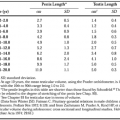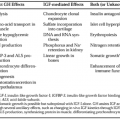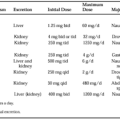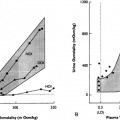Clinically significant diseases of the posterior lobe are rare. Endocrinologically, they can be divided into conditions associated with increased or decreased vasopressin secretion. Several abnormalities are unaccompanied by endocrine alterations.
INAPPROPRIATE SECRETION OF VASOPRESSIN
Inappropriate secretion of vasopressin, or the Schwartz-Bartter syndrome, is the result of vasopressin hypersecretion, either from the posterior pituitary or from extrahypophysial neoplasms (see Chap. 27 and Chap. 219). Renal sodium loss and hyponatremia are characteristic features. Several diseases, including meningitis, myxedema, and cerebral lesions, may be associated with increased vasopressin discharge. Paraneoplastic (“ectopic”) vasopressin secretion may occur in various neoplasms, but is seen mainly in carcinoma of the bronchus. Vasopressin can be extracted from the extrapituitary tumors of patients with vasopressin excess, providing evidence for paraneoplastic (“ectopic”) production of the hormone.
DIABETES INSIPIDUS
Diabetes insipidus is characterized clinically by polyuria and polydipsia (see Chap. 26). In most cases it is caused by vasopressin deficiency resulting from the destruction of supraoptic and paraventricular nuclei, which is where vasopressin is synthesized, or by organic damage to the hypophysial stalk or posterior lobe, which is the site of vasopressin discharge. Morphologically, various lesions can be seen in the hypothalamus, especially in the nucleus supraopticus or along the supraopticohypophysial tract. Selective destruction of the posterior lobe results in only moderate and temporary polyuria and polydipsia. Causes include lesions resulting from head trauma, transection of the hypophysial stalk, meningoencephalitis, sarcoidosis, granulomas, Langerhans histiocytosis, primary tumors, metastatic carcinomas, lymphomas, and leukemias. Of note, pituitary adenomas, including large and invasive ones, are virtually never accompanied by diabetes insipidus as an initial feature of the tumor. The preoperative presence of diabetes insipidus in association with a sellar region mass argues strongly against a diagnosis of pituitary adenoma, however suggestive the imaging studies may be. In idiopathic diabetes insipidus, no destructive lesions can be recognized grossly in the hypothalamus, hypophysial stalk, or posterior pituitary. Histologically, nerve cells of the supraoptic and paraventricular nuclei may show a marked reduction in number and size and loss of stainable neurosecretory material. Immunostaining demonstrates an absence of vasopressin in the hypothalamus, hypophysial stalk, and posterior lobe.
The renal form of diabetes insipidus (nephrogenic diabetes insipidus) is caused by endorgan failure. Renal tubular cells fail to respond to the antidiuretic effect of vasopressin, resulting in polyuria and polydipsia. No lesions are evident in the hypothalamus, hypophysial stalk, or posterior lobe. Vasopressin synthesis and release are not impaired.
BASOPHILIC CELL INVASION
Basophilic cell invasion of the pituitary is a frequent autopsy finding in older men. It causes no clinical symptoms and cannot be detected by gross examination of the pituitary. Histologically, single or small groups of basophilic cells are seen to creep into the posterior lobe. In some cases, large groups of basophilic cells deeply invade the posterior lobe. The cytoplasm of basophilic cells is PAS-positive and contains ACTH and other fragments of the pro-opiomelanocortin molecule, indicating that these cells are related to corticotropes. However, they differ from the corticotropes located in the anterior lobe: they are smaller and denser, and, except for occasional cases, do not show Crooke hyalinization as a result of cortisol excess. Baso-philic cell invasion is not apparent before puberty and cannot be correlated with any clinical endocrine abnormality. From a practical standpoint, the phenomenon of basophil invasion is important only insofar as its presence in a surgical specimen should not be mistaken for a corticotrope adenoma invading the neural lobe of the gland.
MISCELLANEOUS FINDINGS
Squamous cell nests, which are glandular structures resembling salivary glands, and focal mononuclear cell infiltration are common incidental findings at autopsy in the posterior lobe and distal end of the hypophysial stalk. Hemorrhages, necroses, and granulomas were reviewed in the discussion on diseases of the anterior lobe.
INTERRUPTION OF THE HYPOPHYSIAL STALK
Interruption of the hypophysial stalk causes distinct changes along the entire supraopticohypophysial tract. Surgical transection or disruption of the hypophysial stalk secondary to head trauma or organic diseases leads to atrophy of the supraoptic and, to a lesser extent, the paraventricular nuclei, as well as the posterior lobe. Various diseases, such as infections, granulomas, sarcoidosis, and neoplasms, can destroy the supraoptic and paraventricular nuclei and disrupt the hypophysial stalk, thereby impairing the innervation of the posterior lobe. Because the normal functional activity of the posterior lobe depends on the integrity of its nerve supply, diabetes insipidus develops in the absence of innervation. Morphologically, the posterior lobe undergoes marked involution; loss of stainable neurosecretory material and hormone content can be demonstrated. On radio-immunoassay, vasopressin concentrations become undetectable; histologically, neurohypophysial tissue is replaced by a fibrous scar. Atrophy of the posterior lobe is noticeable in some cases of anterior hypopituitarism. In postpartum hypopituitarism, atrophy of the supraoptic and paraventricular nuclei and of the hypophysial stalk and posterior lobe may occur.
Stay updated, free articles. Join our Telegram channel

Full access? Get Clinical Tree








